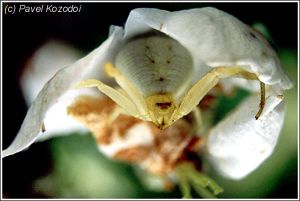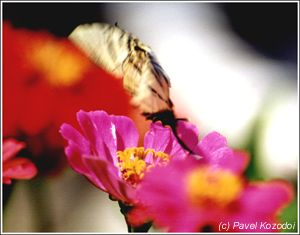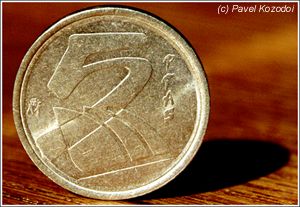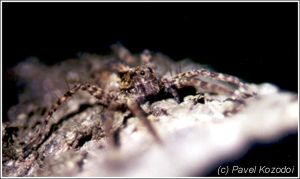| |
All that written here was written under action of spirit of the contradiction, in connection with error of some individuals that a macroshooting is a prerogative of the photographer having макрообъектив (even by Soligor), and all other does not deserve neither right on existence, nor a slightest attention...
|
In last time a photoamateur buying a SLR camera and buy with it as a basic
lens a zoom with a range of focal length from 28 up to
 70-105 mm (a top
limit can be 200-300 mm but this lenses very dear and they have some
negative properties from own universality). It's very logically and often is
accessible. With a help of lenses of that type perhaps to make a shooting of
own family and friends, also a nature of a native land or other lands. In
the further a photoamateur buy a tele zoom with a range of focal length
from 70-100 up to 200-300 mm - for shooting of far object and portraits. So
has developed that photographer, which make shots of nature, tries
simultaneously to make shots of representatives of a microworld. Probably he
understands that the microworld is interesting like a our world or much more
interesting. Existing lenses doesn't let to make shots with a reproduction
ratio (RR) closest than 1:4 (in a better case). But at this time is possible
bought zoom lenses which can receive a RR till 1:2 - it's much better and we
can shoot a close-up without additional equipments. You can choice two zoom
lenses which fill all range from 28 up to 300 mm and let to shoot with a RR
up to 1:2. So, when a photoamateur can't shoot some object with small sizes
in a real RR (on a film),
70-105 mm (a top
limit can be 200-300 mm but this lenses very dear and they have some
negative properties from own universality). It's very logically and often is
accessible. With a help of lenses of that type perhaps to make a shooting of
own family and friends, also a nature of a native land or other lands. In
the further a photoamateur buy a tele zoom with a range of focal length
from 70-100 up to 200-300 mm - for shooting of far object and portraits. So
has developed that photographer, which make shots of nature, tries
simultaneously to make shots of representatives of a microworld. Probably he
understands that the microworld is interesting like a our world or much more
interesting. Existing lenses doesn't let to make shots with a reproduction
ratio (RR) closest than 1:4 (in a better case). But at this time is possible
bought zoom lenses which can receive a RR till 1:2 - it's much better and we
can shoot a close-up without additional equipments. You can choice two zoom
lenses which fill all range from 28 up to 300 mm and let to shoot with a RR
up to 1:2. So, when a photoamateur can't shoot some object with small sizes
in a real RR (on a film),
 he decides this problem and choices one of
following ways. He buys a real macrolens or he buys a set of extension tubes
or a separate tube (about bellows in next time). Of course, everyone wants
to go on the first way, but macrolenses is too dear, in other case it will
possible (but in lists of lenses of independent manufacturers of lenses have
real good macro lenses with a price much less than a price of brand lenses
and it's gives some hope). A real choice - you can bought of a lens with a
possibility of receive a RR till 1:2 or buy a set of extension tubes. Before
this thoughts I already bought a zoom lens with a focal length from 28 up to
80 mm (a maximal RR is 1:5.6) and therefore, from financial point of view,
for a macro shooting I could buy only extension tubes. After this thoughts I
bought a set of auto extension tubes by Soligor.
he decides this problem and choices one of
following ways. He buys a real macrolens or he buys a set of extension tubes
or a separate tube (about bellows in next time). Of course, everyone wants
to go on the first way, but macrolenses is too dear, in other case it will
possible (but in lists of lenses of independent manufacturers of lenses have
real good macro lenses with a price much less than a price of brand lenses
and it's gives some hope). A real choice - you can bought of a lens with a
possibility of receive a RR till 1:2 or buy a set of extension tubes. Before
this thoughts I already bought a zoom lens with a focal length from 28 up to
80 mm (a maximal RR is 1:5.6) and therefore, from financial point of view,
for a macro shooting I could buy only extension tubes. After this thoughts I
bought a set of auto extension tubes by Soligor.
This set of tubes with a zoom lens which have a range of focal
length from 28 up to 80 mm let me to shoot with a RR up to 1.4:1. Tubes have
a very good black matting of inside surfaces and this prevents of any
rereflections and their consequence. Of course a lens works in a
non-standard mode with tubes (macro lenses are special designed for receive
a best quality on close-up distances with a maximal RR).
 But with a help of
tubes we can make a real close-up shooting. When we use tubes and a lens
with a fixed focal length we have a discrete changing of RR (RRs depends
from a number and thickness of tubes). In this case a change of received RRs
possible only when we change a focusing distance. If we use a zoom lens we
have a much better possibility from a point of view of RR changing. A
quality of pictures which gives some zoom lenses aspires to a quality of
lenses with fixed focal length and when we use tubes this distinction is
almost disappears. Therefore a question about a quality of negatives is not
important and especially in a amateur practice. Exist a opinion that
equipments by Soligor have a poor quality (this opinion is most popular in
fans of brand equipments). So, all have own opinions about all themes let
they will be correct not in all cases. It's a life. I can give you my
opinion about extension tubes by Soligor, only about it - I don't use other
equipments from them. Once I was using Nikon FM2 with some brand equipments
and I had a possibility to shoot with a extension tube by Nikon. Has made a
test. I shot a series of equivalent frames with nikon's tube PK-13
(thickness is 27.5 mm) and with tubes by Soligor (thickness is 12 + 20 mm).
A lens was one in both cases. On prints of a format 20x30 cm I didn't find a
different in a quality and I distinguished prints only because the pictures
have a different RRs. So, manufacturing of extension tubes it's not a
manufacturing of lenses (let me say that Soligor has a culture of
manufacture which sufficiently for making good tubes) - nothing of surprised
in this result in my opinion.
But with a help of
tubes we can make a real close-up shooting. When we use tubes and a lens
with a fixed focal length we have a discrete changing of RR (RRs depends
from a number and thickness of tubes). In this case a change of received RRs
possible only when we change a focusing distance. If we use a zoom lens we
have a much better possibility from a point of view of RR changing. A
quality of pictures which gives some zoom lenses aspires to a quality of
lenses with fixed focal length and when we use tubes this distinction is
almost disappears. Therefore a question about a quality of negatives is not
important and especially in a amateur practice. Exist a opinion that
equipments by Soligor have a poor quality (this opinion is most popular in
fans of brand equipments). So, all have own opinions about all themes let
they will be correct not in all cases. It's a life. I can give you my
opinion about extension tubes by Soligor, only about it - I don't use other
equipments from them. Once I was using Nikon FM2 with some brand equipments
and I had a possibility to shoot with a extension tube by Nikon. Has made a
test. I shot a series of equivalent frames with nikon's tube PK-13
(thickness is 27.5 mm) and with tubes by Soligor (thickness is 12 + 20 mm).
A lens was one in both cases. On prints of a format 20x30 cm I didn't find a
different in a quality and I distinguished prints only because the pictures
have a different RRs. So, manufacturing of extension tubes it's not a
manufacturing of lenses (let me say that Soligor has a culture of
manufacture which sufficiently for making good tubes) - nothing of surprised
in this result in my opinion.
 Even if to use a full set of tubes with a zoom
28-80 (RR near 1.4:1) - received prints didn't have significant shifts of
difraction, but depth-of-field, of course, is insignificant in this case and
final prints is a much far from a ideal (but, what is a "ideal"?).
Even if to use a full set of tubes with a zoom
28-80 (RR near 1.4:1) - received prints didn't have significant shifts of
difraction, but depth-of-field, of course, is insignificant in this case and
final prints is a much far from a ideal (but, what is a "ideal"?).
When I bought extension tubes I at once has gone to examine my purсhase. At
shooting in a forest at a sunny day a shutter speed was nearly 1/10 - 1/60 c
with an full opened aperture. Shutter speeds from this range is considerable
for shooting from hands when a lens have a focal length 80 mm and with a
pair of tubes. Therefore is desirable to use a flash with a reflector - for
receiving of more absent-minded light. And much better to use it with a
off-camera cord because a distance between a front lens of a lens and the
object is too small. On a RR near 1:1 a unvisible shaking of hands is
appreciably like at shooting with a powerfull tele zoom lens. For readers
with a humor I mark - this shaking is not a consequence of some abusings,
they begin after of several minutes of situation in a uncomfortable pose at
time of beholding for insects and a waiting of a interesting shot. Very
seldom this waitings is productive from point of view of receiving photos
but they are giving an invaluable information about behaviour of insects,
which will be useful in the future. Besides, it's very interestingly.
 "Why then to not take with itself a tripod? " - you will ask me. Gut question. Well, first
it is inconvenient for carrying. Now you can easily to pick up a tripod of
rather modest dimensions, weight and price, but manufacturers of photobags,
for some reason, do not provide on so-called budget photobags a pair of
adjustable loops for fastening a small tripod. Secondly, very difficult
quickly to get ready a tripod in a working situation and, to place it in a
necessary place for a following shooting. And if with the representatives of
flora it is possible then it's unpossible to use this method for shooting of
small animals and insects - they are too quickly and too cautiously. In that
case if you are ready to run with the camera and tripod, for example, behind
of a butterfly, I at once take off this my remark about a tripod - I can't
do it, because I don't have a big quantities of patience like you. Though,
if to use a some similarity of monopod with a sharp peak on the end,
probably, is possible a rather operatively moving and a fixing of camera in
a new place with a help of inserting this "monopod" in the ground (it's from
mine future planes - try it, should work). More often, I use a such tactic
of shooting: I establish a necessary set of extension tubes and establish on
a focusing ring - an infinity, and on a ring of zoom - a maximal focal
length (total - greatest of a possible focusing distance up to the object).
"Why then to not take with itself a tripod? " - you will ask me. Gut question. Well, first
it is inconvenient for carrying. Now you can easily to pick up a tripod of
rather modest dimensions, weight and price, but manufacturers of photobags,
for some reason, do not provide on so-called budget photobags a pair of
adjustable loops for fastening a small tripod. Secondly, very difficult
quickly to get ready a tripod in a working situation and, to place it in a
necessary place for a following shooting. And if with the representatives of
flora it is possible then it's unpossible to use this method for shooting of
small animals and insects - they are too quickly and too cautiously. In that
case if you are ready to run with the camera and tripod, for example, behind
of a butterfly, I at once take off this my remark about a tripod - I can't
do it, because I don't have a big quantities of patience like you. Though,
if to use a some similarity of monopod with a sharp peak on the end,
probably, is possible a rather operatively moving and a fixing of camera in
a new place with a help of inserting this "monopod" in the ground (it's from
mine future planes - try it, should work). More often, I use a such tactic
of shooting: I establish a necessary set of extension tubes and establish on
a focusing ring - an infinity, and on a ring of zoom - a maximal focal
length (total - greatest of a possible focusing distance up to the object).
 After that I focusing on the object and move in its direction, simultaneously
rotating a focusing ring and, if necessary, a ring of zoom for receiving of
necessary a scale and an accommodation of the object in the frame. Very
often an natural illumination is not enough and a shooting is carried out
with an fully opened aperture. Some of photos, received by me, are submitted
in this article. After some time, at depending on sizes of the object, a
necessary set of rings, not looking, is establish between a camera and a
lens, while there is an observation of movings of the object (orientation of
a position of bayonet is carried out, to the touch, to a lock of lens
position). The tracking of mobile objects of shooting is very necessary
because they are often having a correct coloring i.e. a protecting colouring.
They "disappear" instantly if we remove the sight from they thus the object
which was hardly found can to be easily lost. But, of course, not all
insects and small animals hasten to be hidden at occurrence a Homo Sapiens
with a camera, and if not to be too harmful, is possible to make a shooting
rather long. Though even here possible to meet a "impenetrable" samples,
sometimes, during a lunch, insects are ready to not notice anybody and to
suffer constant inconveniences on the part of photographer. Ok, remains to
write about an ambush (all as in a real hunt, only here are no victims).
After that I focusing on the object and move in its direction, simultaneously
rotating a focusing ring and, if necessary, a ring of zoom for receiving of
necessary a scale and an accommodation of the object in the frame. Very
often an natural illumination is not enough and a shooting is carried out
with an fully opened aperture. Some of photos, received by me, are submitted
in this article. After some time, at depending on sizes of the object, a
necessary set of rings, not looking, is establish between a camera and a
lens, while there is an observation of movings of the object (orientation of
a position of bayonet is carried out, to the touch, to a lock of lens
position). The tracking of mobile objects of shooting is very necessary
because they are often having a correct coloring i.e. a protecting colouring.
They "disappear" instantly if we remove the sight from they thus the object
which was hardly found can to be easily lost. But, of course, not all
insects and small animals hasten to be hidden at occurrence a Homo Sapiens
with a camera, and if not to be too harmful, is possible to make a shooting
rather long. Though even here possible to meet a "impenetrable" samples,
sometimes, during a lunch, insects are ready to not notice anybody and to
suffer constant inconveniences on the part of photographer. Ok, remains to
write about an ambush (all as in a real hunt, only here are no victims).
 It is better to make ambushes at places with a high probability of occurrence
of insects - for different kinds and classes they are various, therefore it
is desirable to consult with experts or to study a special literature. It
can be flowers of plants, rotten fruits, an input in refuge (for example an
inputs in refuges of spiders and earthen bees), observing positions of
dragonflies, spider's nets etc. All tactics and features of photohunting in
more detail are described in articles by Ivan Sazykin "A photohunting on
insects" (№ 4'98) and "Macroshooting of insects in field conditions" (№
1-2'2000), which was published in a magazine "Fotomagazine". Therefore I'm
sending you for more details to those remarkable articles, but I was must to
give you a little information about this theme, it was necessary for
completeness of a submitted here material.
It is better to make ambushes at places with a high probability of occurrence
of insects - for different kinds and classes they are various, therefore it
is desirable to consult with experts or to study a special literature. It
can be flowers of plants, rotten fruits, an input in refuge (for example an
inputs in refuges of spiders and earthen bees), observing positions of
dragonflies, spider's nets etc. All tactics and features of photohunting in
more detail are described in articles by Ivan Sazykin "A photohunting on
insects" (№ 4'98) and "Macroshooting of insects in field conditions" (№
1-2'2000), which was published in a magazine "Fotomagazine". Therefore I'm
sending you for more details to those remarkable articles, but I was must to
give you a little information about this theme, it was necessary for
completeness of a submitted here material.
Of course, a shooting with the tubes does not allow to receive a quality of
real macrolens and does not allow to work also operatively. Yes, shooting
with a combination of "basic" zoom lens and a complete set of tubes is very
hardly, but it is very training a discipline and accustoms to a patience,
that is very important at any kind of shootings. Besides, extension tubes,
is allowing to shoot in a real close-up and is helping to a photographer to
understand his necessity in a real macrolens. To buy a real macrolens, if a
level and an intensity of macroshooting is such that enough of extension
tubes? In all cases a pair of tubes never will superfluous in professional
and in a amateur practice.
I hope, that I proved for doubt mans the right on a existence
in a macroshooting of a combination a "basic" zoom lens and extension tubes.
Amateurs, which used this combination, despite of all my assurances and
proofs, all the same will be dreaming about a real macrolens, looking in the
view-finder on a wing of butterfly, shining on the sun, on next
macrohunting. It's true, I know...
|